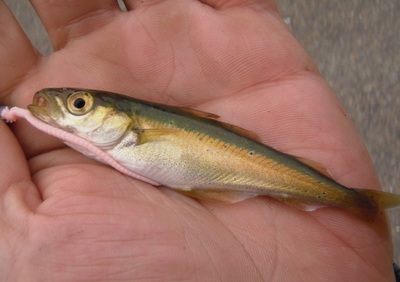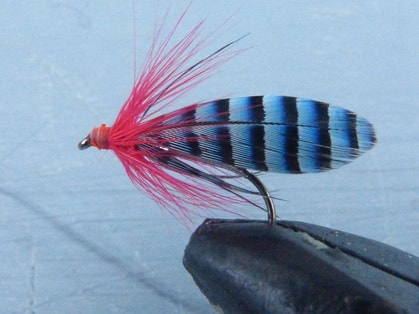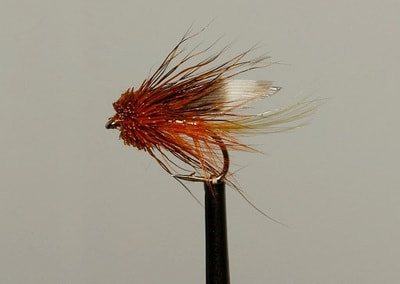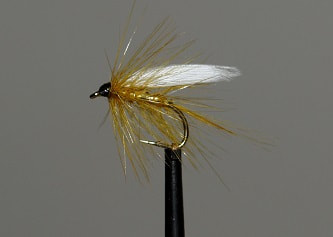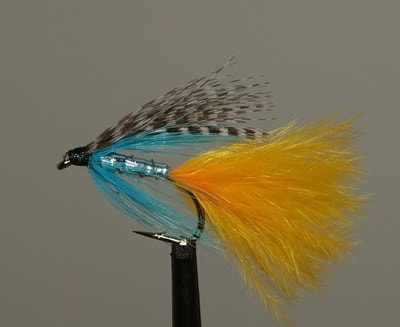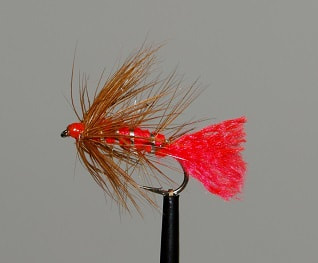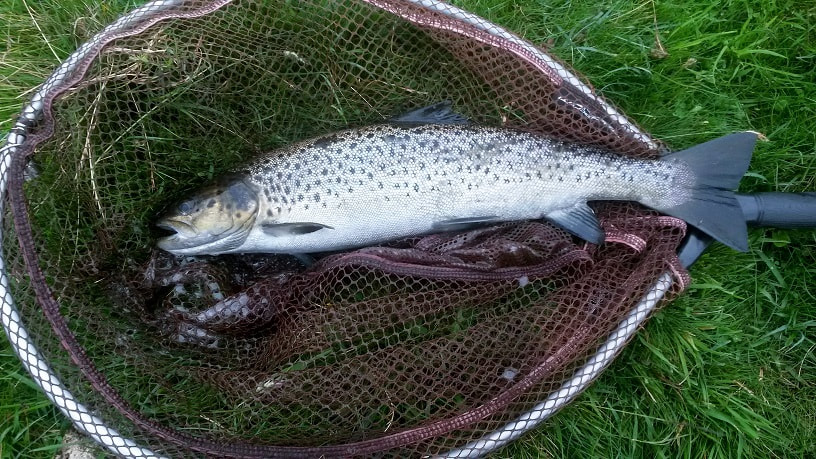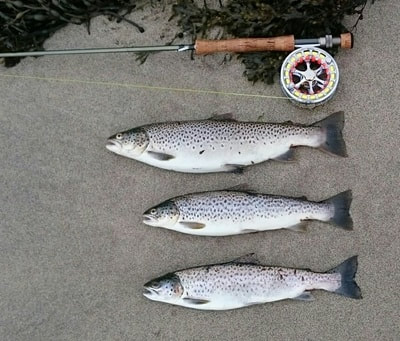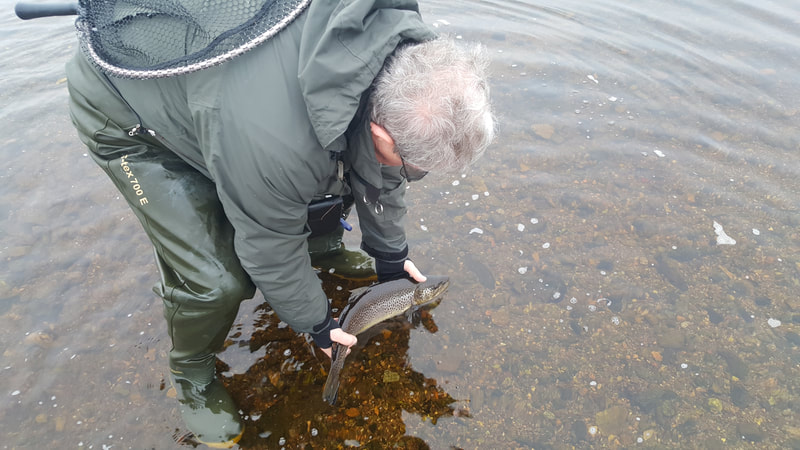SHETLAND SEA TROUT FISHING |
Shetland was at one time considered to be one of the top venues to fish for Sea Trout in Europe. During the 1950's and 60's anglers would travel from mainland Britain and from even further afield to catch sea trout in the burns, lochs and more famously in the “voes” and bays surrounding the Shetland coastline. Voes are long, narrow sea inlets created during the last ice age when sea levels rose and flooded the lower reaches of the small streams that drained the Shetland countryside. Like the north and west coasts of Scotland, Shetland sea trout fishing seriously declined in the 1980's the blame being put down to a combination of seals, local poaching, over-fishing of sand eels commercial salmon farming, and global warming.

RESTOCKING
In recent years the sea trout have made a bit of a comeback largely due to the efforts of the Shetland Anglers' Association who has embarked on a program to supplement the depleting wild stocks with sea trout fry reared from brood stock. Funding for the restocking programme came from SAA memberships, income from visitors as well as some support from Shetland Islands Council. The Association has concentrated its efforts largely on restocking locations that had good runs in the past and has been encouraged with the results so far.
The Association has planted out approximately 100,000 sea trout fry in the burns and lochs of Shetland during March 2016 as part of their continued efforts to improve the sea trout runs.
LOCATIONS
With a coastline extending to more than 1600 miles, Shetland offers massive potential for locating sea trout. It has to be said however that sea trout are not found in the quantities that existed over half a century ago so finding the hot spots can be challenging. Global warming, over-fishing of sand eels and other contributory factors have meant that the sea trout have had to adapt in order to survive so finding their main feeding grounds is the key to success. Sea Trout angling tends to be fast and furious – one minute they are there and next they are gone! Occasionally you may be fortunate enough to keep up with the shoal and you may have an hour or two's excitement but in the main they disappear as quickly as they came or they just wise up to your presence! A sea trout's diet is extremely varied but will largely comprise of shrimp, sand eels, rag-worm, sea slaters and small fish such as immature pollack, coalfish, sprats and herring fry. Their versatility means that they are often partial to anything that looks like a potential food item so if you can find their main foraging grounds you could be in for some real excitement! They may be found in the tidal races and sea pools locally called “houbs” where they can intercept shrimp or shoals of immature pollack and coalfish. Timing is very important when it comes to targeting sea trout and the best fishing tends to be in the two hours leading up to and the two hours after low water. During this period, of relative low water, sea trout are concentrated in the various races, pools and eddies rather than foraging over shallow featureless flats and deeper water where they might fall prey to seals. The periods around both the bottom and top of the tide can be a bit of a dead time as there is nothing to “move” the food items. Once the tide begins to turn and prey items begin to move, the fishing can get really exciting.
As far as conditions go, sea trout fishing in the sea during periods of bright sunlight can be relatively unproductive. If however there is a wind (which is not uncommon in Shetland!!) there may be opportunities to catch even during these difficult periods.
As there are no rivers in Shetland sea trout tend to start to congregate in the voes from July and onwards as they await opportunities to run the burns to spawn. They may run the burns at any time if there is sufficient water and the tides are right.
As a general rule avoid areas where cages are present. Even voes where cages are located several miles away at the mouth may be unproductive due to the presence of denser than normal numbers of sea lice. Half the excitement of sea trout fishing is using your experience as an angler to seek out the most productive locations. Look for indicators that fish are present. For example the presence of seals close to the shoreline may be an indication that fish are there. If there are gulls hunting over the surface it will mean that there is probably a shoal of fry present which may mean that sea trout are there also. If you are fortunate enough to catch one fish there may be others present as sea trout tend to congregate in shoals.
The best time of year to try your luck for sea trout is from mid-June through to the end of the season, September and October often being best. In the early season (February to April) most of the fish are in fairly poor condition as they recover from spawning and the winter months when food is generally scarce. Anglers are encouraged to return their fish.
With a coastline extending to more than 1600 miles, Shetland offers massive potential for locating sea trout. It has to be said however that sea trout are not found in the quantities that existed over half a century ago so finding the hot spots can be challenging. Global warming, over-fishing of sand eels and other contributory factors have meant that the sea trout have had to adapt in order to survive so finding their main feeding grounds is the key to success. Sea Trout angling tends to be fast and furious – one minute they are there and next they are gone! Occasionally you may be fortunate enough to keep up with the shoal and you may have an hour or two's excitement but in the main they disappear as quickly as they came or they just wise up to your presence! A sea trout's diet is extremely varied but will largely comprise of shrimp, sand eels, rag-worm, sea slaters and small fish such as immature pollack, coalfish, sprats and herring fry. Their versatility means that they are often partial to anything that looks like a potential food item so if you can find their main foraging grounds you could be in for some real excitement! They may be found in the tidal races and sea pools locally called “houbs” where they can intercept shrimp or shoals of immature pollack and coalfish. Timing is very important when it comes to targeting sea trout and the best fishing tends to be in the two hours leading up to and the two hours after low water. During this period, of relative low water, sea trout are concentrated in the various races, pools and eddies rather than foraging over shallow featureless flats and deeper water where they might fall prey to seals. The periods around both the bottom and top of the tide can be a bit of a dead time as there is nothing to “move” the food items. Once the tide begins to turn and prey items begin to move, the fishing can get really exciting.
As far as conditions go, sea trout fishing in the sea during periods of bright sunlight can be relatively unproductive. If however there is a wind (which is not uncommon in Shetland!!) there may be opportunities to catch even during these difficult periods.
As there are no rivers in Shetland sea trout tend to start to congregate in the voes from July and onwards as they await opportunities to run the burns to spawn. They may run the burns at any time if there is sufficient water and the tides are right.
As a general rule avoid areas where cages are present. Even voes where cages are located several miles away at the mouth may be unproductive due to the presence of denser than normal numbers of sea lice. Half the excitement of sea trout fishing is using your experience as an angler to seek out the most productive locations. Look for indicators that fish are present. For example the presence of seals close to the shoreline may be an indication that fish are there. If there are gulls hunting over the surface it will mean that there is probably a shoal of fry present which may mean that sea trout are there also. If you are fortunate enough to catch one fish there may be others present as sea trout tend to congregate in shoals.
The best time of year to try your luck for sea trout is from mid-June through to the end of the season, September and October often being best. In the early season (February to April) most of the fish are in fairly poor condition as they recover from spawning and the winter months when food is generally scarce. Anglers are encouraged to return their fish.
TYPICAL SEA TROUT FOOD
ANGLING METHODS
As with brown trout the most popular form of angling is fly fishing however they may be taken on spinners and other lures and have been known to take mackerel strip and worm. There is something far more satisfying and exciting about catching a sea trout on a fly and in the 50 years or so that I have been fishing for them more than 40 of those have been devoted almost exclusively to fly fishing. To me the thrill of catching a fresh run sea trout on a fly rod far exceeds catching them on spinner or bait. I would recommend that fly fishing should be carried out with a floating line and small flies (sizes 8-12). A 9.5' to 10' single-handed rod is recommended . Lines are normally #6-#8 floating or intermediate, though a slow-medium sinking line is useful during calm periods. All lines should have at least 75 yards of backing on them as a fresh run 2lb plus fish can strip off at least 50 yards of line on it's maiden run. Very heavy tackle and rods are not considered to be necessary. Keep the retrieve brisk to simulate fast moving prey. Sea trout like to chase their food and a quick retrieve is almost always more effective than trying to fish flies as a dead drift.
FLIES
My preference is for a two fly cast comprising something bright on the dropper and either a shrimp or sand eel imitation on the tail. In heavily weeded areas I sometimes cut down to a single fly cast as you can easily lose a good fish if it runs for cover in a patch of seaweed. Some recommended patterns that have been successful for me are shown below.
SEA TROUT PATTERNS
As with brown trout the most popular form of angling is fly fishing however they may be taken on spinners and other lures and have been known to take mackerel strip and worm. There is something far more satisfying and exciting about catching a sea trout on a fly and in the 50 years or so that I have been fishing for them more than 40 of those have been devoted almost exclusively to fly fishing. To me the thrill of catching a fresh run sea trout on a fly rod far exceeds catching them on spinner or bait. I would recommend that fly fishing should be carried out with a floating line and small flies (sizes 8-12). A 9.5' to 10' single-handed rod is recommended . Lines are normally #6-#8 floating or intermediate, though a slow-medium sinking line is useful during calm periods. All lines should have at least 75 yards of backing on them as a fresh run 2lb plus fish can strip off at least 50 yards of line on it's maiden run. Very heavy tackle and rods are not considered to be necessary. Keep the retrieve brisk to simulate fast moving prey. Sea trout like to chase their food and a quick retrieve is almost always more effective than trying to fish flies as a dead drift.
FLIES
My preference is for a two fly cast comprising something bright on the dropper and either a shrimp or sand eel imitation on the tail. In heavily weeded areas I sometimes cut down to a single fly cast as you can easily lose a good fish if it runs for cover in a patch of seaweed. Some recommended patterns that have been successful for me are shown below.
SEA TROUT PATTERNS
Ragworm (see the tying for this fly in Cast of the Month - Marvin Tait for April 2016)
LIST OF POSSIBLE SEA TROUT LOCATIONS
This list is far from comprehensive as sea trout can be found almost anywhere around the coastline. Anglers are encouraged to try different locations for themselves.
Please bear in mind that sea trout are sensitive to angling pressure and whilst there are no basket limits, anglers are requested to appreciate the need for conservation of stocks.
1. Spiggie Beaches, Dunrossness |
10. Dury Voe |
2. Weisdale Voe |
11. Catfirth Voe, Nesting |
3. Bixter Voe |
12. Dales Voe, Lerwick |
4. Bridge of Walls |
13. Hamnavoe, Yell |
5. The Vadills, West Burrafirth |
14. West Sandwick, Yell |
6. Ronas Voe, Northmavine |
15. Gloup Voe, Yell |
7. The Brig of Collafirth, Northmavine |
16. Burrafirth Beach, Unst |
8. Dales Voe (Dales Lees), Delting |
17. Baltasound, Unst |
9. The Pool of Laxfirth (Laxo) |
18. Uyeasound, Unst |
Report by Mike Forbes February 2016 LAST UPDATED: 18 March 2019 |
. |





